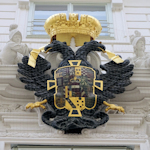
If you’re popping into the town centre for some milk and bread, it’s handy to have your own house to shelter in should it rain.
Which is presumably why Prince Eugene of Savoy (1663-1736) kept a Winterpalais in what is now Vienna’s first district.
- 17th/18th-century townhouse with glorious staterooms
- Now owned by the Ministry of Finance
- No longer open to the public
- See also:
Winter palace history

(Now home to federal employees)
The Winterpalais (winter palace) dates back to 1696. A few years after owner Prince Eugene’s death in 1736, the building entered state ownership under Empress Maria Theresia.
For a long while, the palais provided offices for the finance ministry, but Eugene’s richly-appointed city residence enjoyed a brief life more recently as a venue for regular art exhibitions as part of the Belvedere group.
This allowed the public to see the refurbished staterooms and gain insights into the lives and luxuries of the more wealthy denizens of 17th and 18th century Vienna. The city palais was not a standalone building, but threaded into one of Vienna’s historic inner city streets.
This opportunity ended in 2017 when the finance ministry reclaimed the rooms. So you can no longer visit. Bah humbug.
I’m not going to complain too much. This is, after all, the ministry that decides if I should get a tax audit. Besides, you can still admire the façade and richly-decorated entrance. If you do, check out the coffee house next door, which opened in 1824.
Inside the Winterpalais
For what it’s worth, here’s a review of the interior from the time when you could visit:
A red carpet leads you into the palace, past the toilets and lift, and up the huge stone stairway. This is where you get your first impression that the former owner may not have struggled to pay the heating bills.
Stone statues flank this grand staircase, with a relaxed-looking Hercules figure half way up, resting his weapon like a bored nightclub bouncer.
The top of the stairs takes you into the small shop and ticket counter and the ten or so rooms that make up the viewable staterooms.
These rooms reminded me of the Albertina, with the decorated hardwood floors and silk-lined wall panels (warning: I’m not an expert on period decor, so I may be out by a few decades with the comparison).
Particular highlights:
- The many panels featuring geometric forms and scrollwork with their curious faces and figures
- The giant mirrors, presumably put in to create the illusion of bigger rooms
- The “Gold Cabinet” room, with its incredibly ornate ceiling (in gold) and floral designs edged in…gold
- The “Hall of Battle Paintings”, which you’ll be surprised to hear is a large room full of giant paintings of battle scenes. These include some of Prince Eugene’s greatest triumphs, such as the Relief of Turin in 1706 or the 1717 Siege of Belgrade (the famous mortar from that same battle can be seen in the Heeresgeschichtliches Museum)
- The somewhat incongruously-placed little chapel room attached to the Hall of Battle Paintings. It has an altar, and the walls are painted to give the impression you’re kneeling in a real stone chapel
How to get to the Winterpalais
The palace is in the very center, on a side road just 100m from the main shopping street of Kärntner Straße. So there’s a strong chance you’ll be nearby if you’re visiting the usual city centre sights.
Subway: the closest station is Stephansplatz (lines U1 and U3), which is 5 minutes walk away.
Bus: take the 2A to Plankengasse (also 5 minutes walk away).
Tram: the nearest trams are on the Ring that circles the centre. Catch the line 2 tram to Weihburggasse, then it’s another 5 minutes walk.